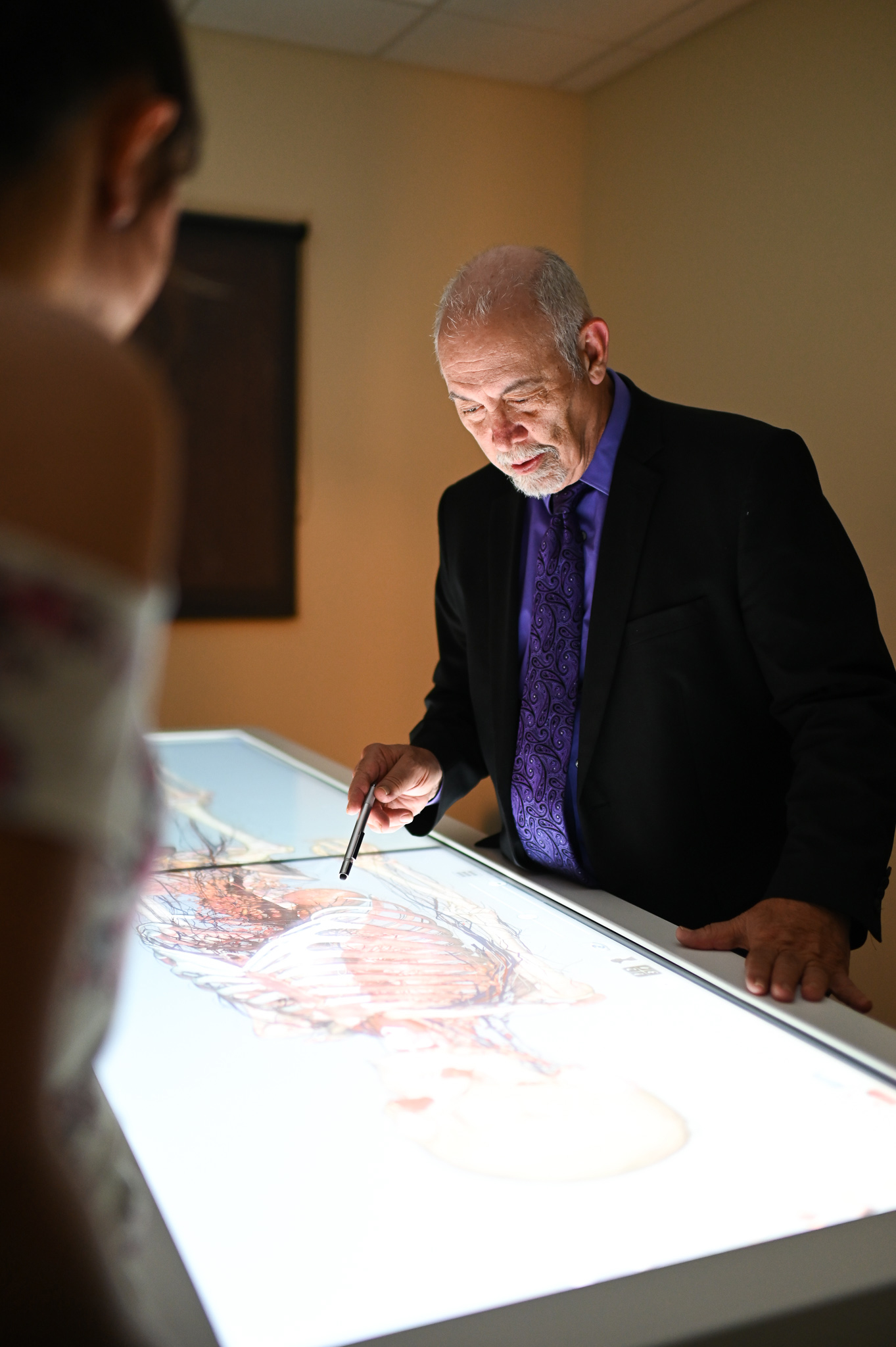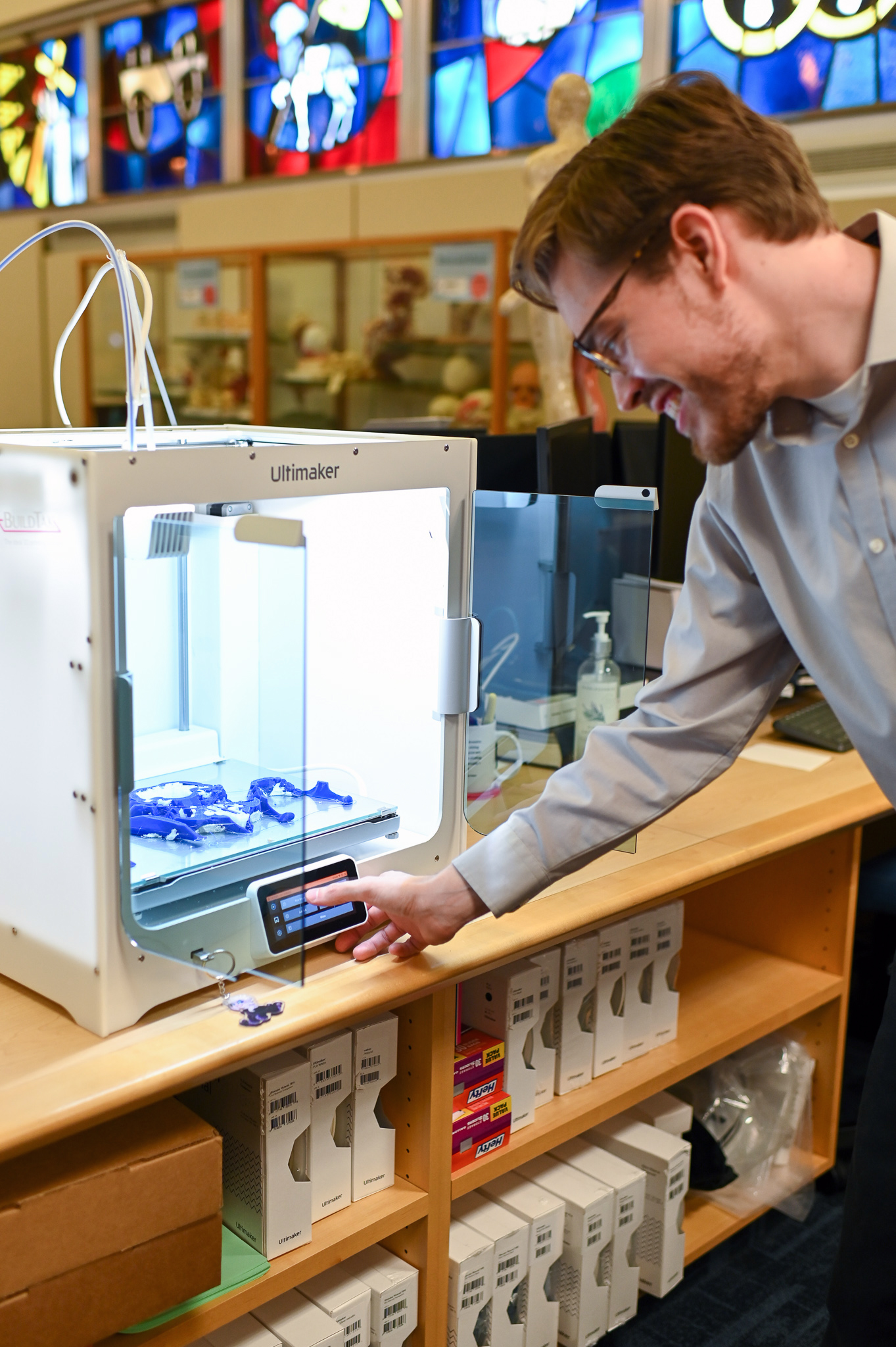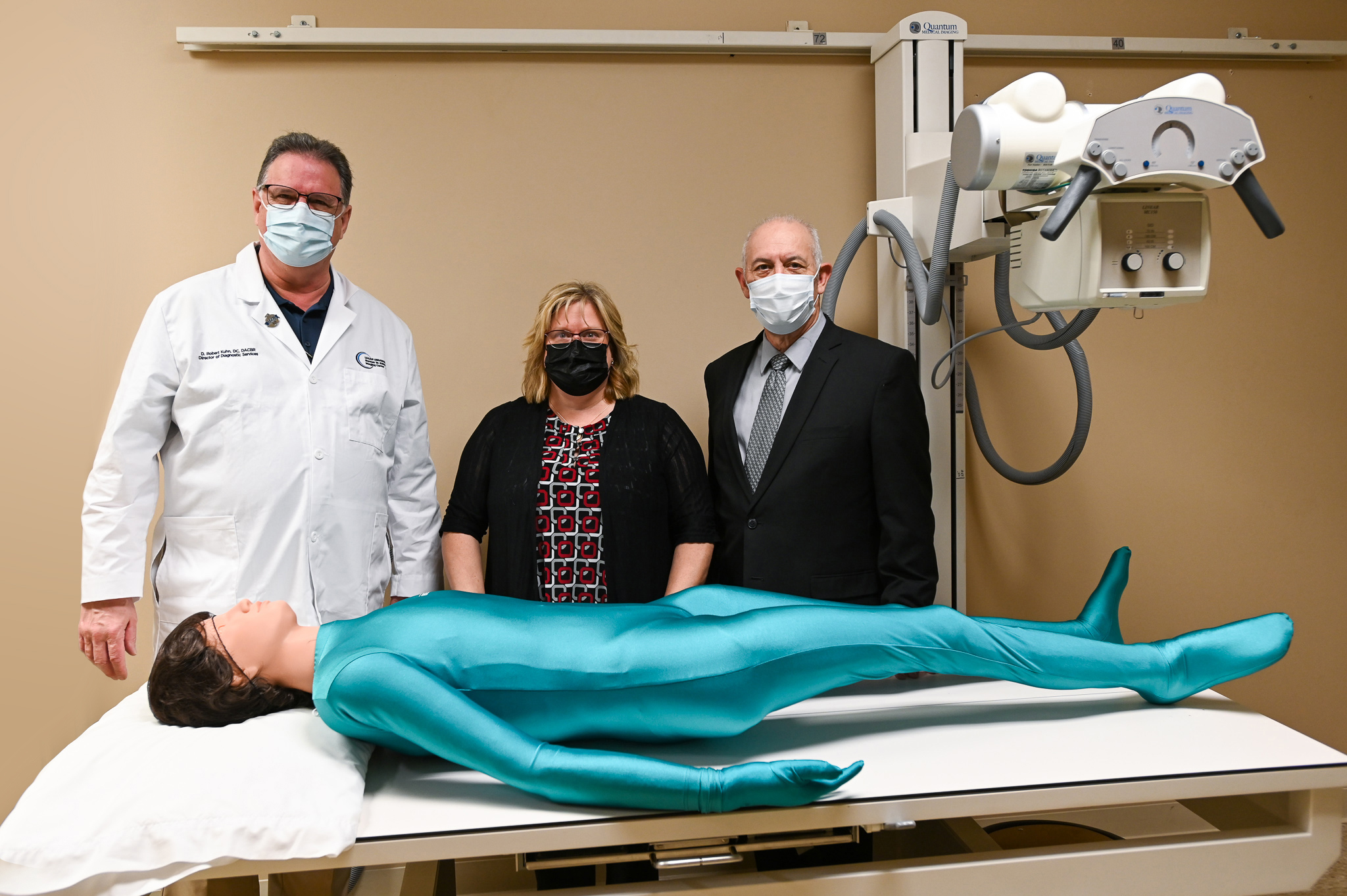Master the Skills to Manage Your Future.
Offering expert training in more techniques than any other chiropractic college, Logan lets you chart your own path to becoming a health care leader. Here, you’ll learn one of chiropractic’s foundational techniques at the institution that perfected it. Today, Logan Basic is one of four techniques at the heart of our DC program. Complement your core training with electives in 11 other techniques.

Core Chiropractic Techniques
Logan Basic
Developed by Logan University founder, H.B. Logan, DC, Logan Basic is one of the lowest-force adjustive techniques. A system of body mechanics with special emphasis on pelvic and spinal distortions and the subluxations that affect spinal structures, Logan Basic Technique is a light force, full-spine adjusting procedure highlighting the correction of spinal and pelvic pathobiomechanics. This year-long course emphasizes the clinical indicators of spinal distortions, postural evaluation and the use of spine X-ray analysis. Students also study chiropractic management of special conditions, such as scoliosis, pregnancy, pediatric care and acute and chronic spinal conditions.
Diversified Technique
One of the most commonly used techniques in chiropractic treatment, Diversified courses focus on chiropractic terminology and conceptual models of pelvic and spinal biomechanics. Students learn to analyze and label pelvic and vertebral subluxation complexes. The laboratory portion of the course emphasizes manual contacts, vertebral contacts stances, and patient positioning.
Activator Methods®
Backed by extensive published research on its effectiveness, Activator Methods® is a foundational adjustment technique in Logan’s core DC curriculum. This technique offers the doctor the flexibility to perform a chiropractic adjustment on a variety of patients, regardless of age or condition.
Myofascial Technique
Myofascial Technique is a soft tissue therapy that relaxes contracted muscles, improves circulation and stimulates the stretch reflex in muscles. Emerging evidence demonstrates that the human myofascial system is a body-wide communication network with a broad effect on overall health and wellness. In this important course, students cover a variety of concepts on various soft tissue therapies and their effect on the myofascial system. Specific soft tissue techniques are offered through a number of elective courses.
Elective Techniques
Design your curriculum to match your career goals and interests. Logan offers expert instruction in 11 elective techniques to enhance your education and skills.
Focusing on muscular and soft-tissue problems, ART® is based on research indicating that adhesions may develop within muscles and between nerves, blood vessels and connective tissue as a result of both acute and repetitive injuries. These adhesions may affect the muscle function and change joint motion, resulting in altered biomechanics and a variety of peripheral nerve entrapment.
Developed by P. Michael Leahy, DC, CCSP, ART grew out of Leahy’s work in neuromuscular re-education and Myofascial Release. The Law of Repetitive Motion is a unifying concept, explaining how overuse syndromes arise from a variety of events and still fit under one paradigm. Practitioners work with various soft tissues to restore optimal function by releasing adhesions. Each muscle involved in the overuse syndrome is thoroughly assessed. ART is based on an assessment of each muscle involved in the overuse syndrome, and is often applied in the treatment of athletes, office and factory workers and others affected by any of a variety of overuse syndromes.
Enhancing the skills taught in our core Activator Method course, the Advanced Activator Method course will reinforce and advance your knowledge and skill in this popular technique, preparing students to become Advance Certified.
Building on the skills learned in our core Logan Basic Technique course, Advanced Basic Technique will refine your understanding and skill in the application of Logan Basic as an adjusting technique. Students will receive an overview of other adjusting techniques and adjunct procedures, including chiropractic physiotherapy and exercise for patients with scoliosis. Focusing on functional and idiopathic scoliosis, the course takes an evidence-based approach to treating this complex, systematic condition and its co-morbidities. The importance of case history, radiological, physical, neurological, orthopedic, endocrine, blood and urine exams and their results, as well as the roles of diet and exercise will be discussed.
Furthering materiel presented in our core Reinert Diversified series, Advanced Diversified Technique courses are designed to improve skills in patient diagnosis, treatment and management using the Diversified Technique methods. Practicing Doctors of Chiropractic will present and discuss actual case studies and the outcomes.
This method employs a system of muscle testing and assessment to determine whether certain muscles are consistently weak. Based on the results of the exam and patient history, appropriate diagnostic work-ups, including lab work and X-rays, are used. This approach was developed by George Goodheart, DC, by identifying relationships between certain muscles and the function of corresponding organs. In Europe, this method is often used by medical doctors and dentists to supplement other diagnostic information.
Treatment with Applied Kinesiology includes chiropractic adjustments using a variety of techniques. Work on affected muscles and related reflex systems as well as nutritional programs may also be used. Many practitioners report that adjusting is easier after Applied Kinesiology muscle work, as the technique helps balance the muscles surrounding the spine.
Developed by James M. Cox, DC, the Flexion-Distraction adjustment procedure and enhanced adjusting table are based on a distractive force (supplied with the contact hand) combined with table motion. The Cox table is designed to restore normal physiological range of motion to the cervical, thoracic, and lumbar spinal joints. Cox Flexion-Distraction manipulation is a gentle, non-force adjusting procedure that works with the body’s natural design to aid in healing.
The Cox Flexion-distraction adjustment was also designed to transfer metabolites into the spinal disc, decrease intradiscal pressure and decompress inflamed or compressed spinal nerve roots. This technique has received three government-funded grants totaling over $2 million and have been awarded to support the further study of this effective technique.
Developed in 1923 by the late Clarence S. Gonstead, DC, the Gonstead System uses visual examination, motion and static palpation, instrumentation and full-spine X-rays to determine precisely where, what, when and how to adjust to obtain specific and consistent results.
The System uses the full-spine approach with emphasis on the subluxation/compensation mechanism and level disc concept. Emphasizing differentiation between the sympathetic and the parasympathetic nervous systems and their symptoms, the Gonstead System helps the chiropractor find and correct the specific subluxation. Specialized equipment, including the Knee Chest, Pelvic Bench, Hylo Tables and Cervical Chair, is used in applying the adjustive technique.
Instrument Assisted Soft Tissue Mobilization (IASTM) is an intense hands-on study of soft tissue treatment using state-of-the-art tools to mobilize aberrant soft tissue issues such as adhesions and scar tissue throughout the entire body. Soft tissue as an adjunctive method is also discussed. The course includes all equipment.
SOT was developed by Bertrand DeJarnette, DC, a wealthy former engineer who dedicated much of his fortune to fund research into why chiropractic works. Dr. DeJarnette concluded that any area of the spine can be affected by structural changes affecting the dura, the dense membrane of connective tissue surrounding the the brain and spinal cord. He found that adjusting one segment of the spine can cause change in another.
Intrigued by research showing that cranial bones move, Dr. DeJarnette theorized that structural changes of the cranial bones could affect the movement of cerebrospinal fluid. Thus, SOT addresses the positioning of the cranial bones using a method called craniopathy.
The preferred method of many SOT practitioners for addressing pelvic subluxations, blocking involves blocks places beneath the pelvis with the patient lying face-up. By normalizing joint positions on both sides of the spine simultaneously, SOT integrates with other chiropractic systems, allowing for use of a variety of techniques within the SOT system. Many practitioners also provide nutritional counseling to their patients.
Named for its founder, Clay Thompson, DC, Thompson Technique uses an adjusting table with a pneumatically driven, segmented drop system which quickly lowers the portion of the table under the corresponding section of spine being adjusted. Using minimal force, the doctor thrusts at high speed, allowing the fast drop to carry the joint through its range of motion.
Thompson practitioners use leg length checks, palpation, X-rays and other appropriate tests to determine the proper area to be adjusted. Although he was the personal physician of chiropractic founder B.J. Palmer, DC, Dr. Thompson advocated adjustments addressing any joint dysfunctions in the spine as well as the extremities.
Developed by chiropractic founder D.D. Palmer, DC and refined by his son, B.J. Palmer, DC, Upper Cervical Specific Technique focuses on the Atlas Subluxation Complex (ASC). Made up of three osseous components at the top of the human spine—the Occiput (skull or CO), the Atlas (CI) and the Axis (C2)—the technique focuses on specific corrections to the structure of the Atlas complex to restore correct structure and promote optimal function of nerves related to the complex.
Upper Cervical Specific is a toggle recoil technique, in which the adjustment establishes motion, following the proper line of correction, allowing the segment to find its natural position innately. These procedures differ from techniques using Gonstead listings in that Upper Cervical’s 12 atlas and eight axis listings (misalignments) are compared relative to the foramen magnum (the opening in the bones at the base of the skull).
Our anatomage center contains Anatomage Tables, the most technologically advanced 3D simulation systems available, and virtual dissection tables, which allow students to view real human anatomy.
Our Chiropractic technique labs include force plate technology using embedded sensors on a human torso model to provide students with immediate feedback on their performance delivering spinal manipulation. The Activator Technique Lab will be furnished with the latest electronic Activator instruments, which produce an electronic thrust of pressure at the touch of a button, helping prepare students for their entry into the field of chiropractic.
The radiography center trains our students with equipment like what is currently used in the Montgomery Health Center and provide supervised practice time outside of class.
Leading Edge Technology
For over 80 years, Logan University has set a high standard for innovative education. Introducing state-of-the-art technologies into its curriculum and clinical services enhances the learning experience with new opportunities that prepare Logan students and graduates to enter their professions as highly trained, skilled and knowledgeable health care professionals.
Anatomage Center
Our anatomage center contains Anatomage Tables, the most technologically advanced 3D simulation systems available, and virtual dissection tables, which allow students to view real human anatomy.
Chiropractic Technique Labs
Our Chiropractic technique labs include force plate technology using embedded sensors on a human torso model to provide students with immediate feedback on their performance delivering spinal manipulation. The Activator Technique Lab will be furnished with the latest electronic Activator instruments, which produce an electronic thrust of pressure at the touch of a button, helping prepare students for their entry into the field of chiropractic.
Radiography Center
The radiography center trains our students with equipment like what is currently used in the Montgomery Health Center and provide supervised practice time outside of class.


